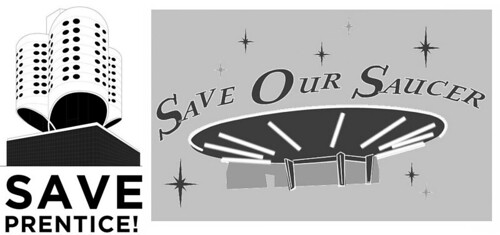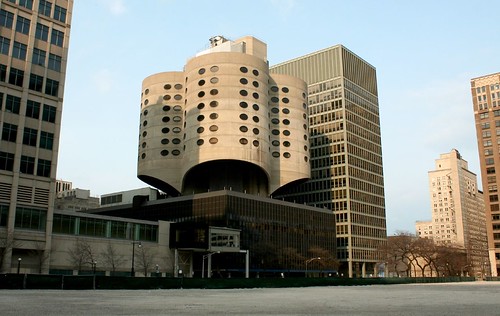
I'm duplicating this post across two blogs, because two parallel battles are being fought right now over MidCentury buildings in Chicago and St. Louis.

In Chicago, a well-publicized fight has been going on for many months over the fate of the Prentice Women's Hospital at Northwestern University Hospital's downtown campus. Prentice is a high-rise building by Bertram Goldberg, the same architect who developed the corn-cob Marina Towers on the Chicago river, and two other complexes in a similar idiom south of downtown. The building has been vacated by Northwestern Hospital, which originally expressed a desire to demolish it, though no plan for using the land has been developed.

In St. Louis, Midtown's "flying saucer" building - originally a gas station, now a Del Taco fast food outlet - has been the center of a much swifter controversy, as the owner announced plans to demolish it and build a new retail building in its place. The St. Louis community immediately rose up in righteous grassroots wrath. Driven by an unholy alliance between MidCentury architectural preservationists and fans of Del Taco chain (a mainstay of late night food, particularly for students at nearby Saint Louis University), the issue has flared across local news and been debated at the level of the city council.
Several interesting parallels stand between these buildings and their champions. Both are from the 1960s, built of concrete, and defined by dramatic cantilevers and round forms. And both lend themselves to diagramatic simplification in the form of the line drawings up above - a simple, clear expression of the buildings' big ideas, a clear illustration of the dramatic simplicity that defines them. Those two drawings summarize one of the big trends in Modernism - simple, bold design moves, with dramatic but carefully considered lines and proportions.
Such representations are eminently useful in getting people to see past the more transitory elements of the buildings. A number of St. Louis residents have commented about bad memories or experiences with Del Taco, and called for demolition - as if the building itself were responsible for the business within it. Likewise, Prentice has the maintenance issues one would expect of any building that's approaching 50 years old, with stained and spalling concrete in need of cleaning and repair.
Finally, both buildings are fine examples of the growing need for Midcentury awareness and preservation. Nobody is building these things anymore - once they're gone, they're gone forever.